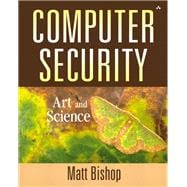The importance of computer security has increased dramatically during the past few years. Bishop provides a monumental reference for the theory and practice of computer security. This is a textbook intended for use at the advanced undergraduate and introductory graduate levels, non-University training courses, as well as reference and self-study for security professionals. Comprehensive in scope, this covers applied and practical elements, theory, and the reasons for the design of applications and security techniques. Bishop treats the management and engineering issues of computer. Excellent examples of ideas and mechanisms show how disparate techniques and principles are combined (or not) in widely-used systems. Features a distillation of a vast number of conference papers, dissertations and books that have appeared over the years, providing a valuable synthesis. This book is acclaimed for its scope, clear and lucid writing, and its combination of formal and theoretical aspects with real systems, technologies, techniques, and policies.
The most complete book on information security theory, technology, and practice from a well-recognized security authority and educator.
- Matt Bishop is an expert in information assurance and robust, safe code- important topics today.
- Current with the latest developments.
- Well-suited to become the leading security textbook.
NOTE: This book is now printed in two volumes








